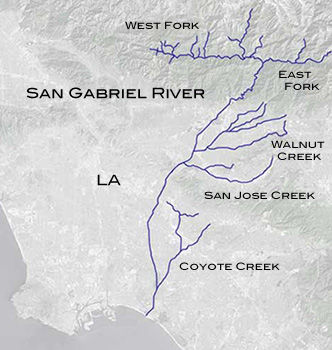“When the well is dry, we know the worth of water.”
–Benjamin Franklin
The San Gabriel Watershed supplies the Los Angeles region with nearly one quarter of its water. The river runs freely and continuously in its upper reaches in the Angeles National Forest, but it disappears and then (astonishingly) reappears farther downstream as municipal water districts mange its flow. The resurgence of the river in its lower stretches is largely due to the discharge of waste treatment plants. What was once a meandering stream through marshy wetlands has now become a concrete storm channel carrying discharged, processed effluent.
I began photographing the river when I learned that regional conservation groups were proposing to create a wildlife corridor along its length. Pockets of native habitat designated as Significant Ecological Areas still remain along the river corridor, but the majority of the river runs through an awkward mixture of urban, suburban and industrial lands. Despite the overwhelming odds against such a project, I am fascinated by the idea of weaving a thread of wilderness back into the urban landscape. Such corridors are becoming increasingly common throughout the world as suburban sprawl severs once robust and interdependent ecological communities.
